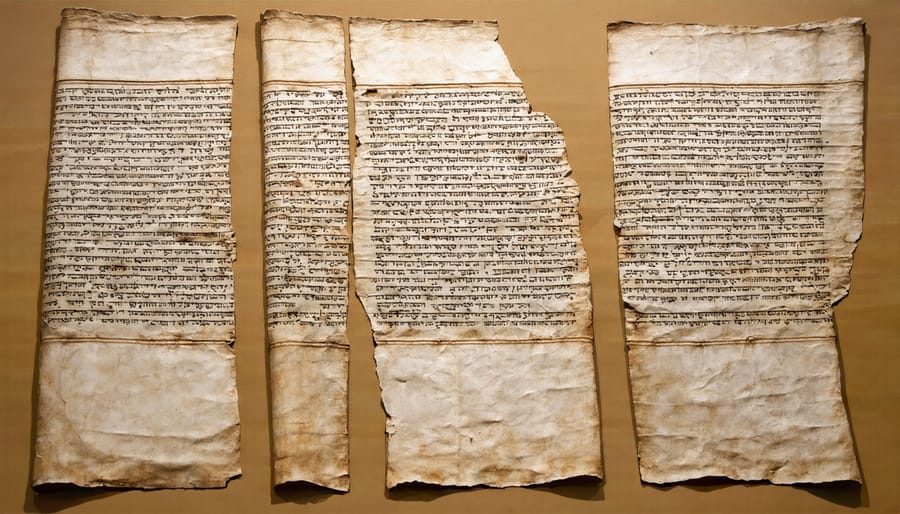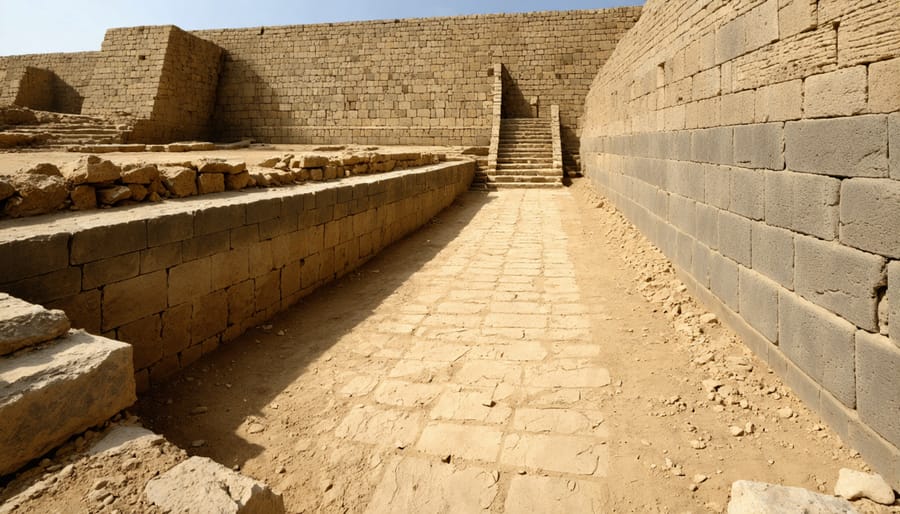Buried beneath centuries of sand and stone lie remarkable discoveries that continue to affirm the historical accuracy of God’s Word. Modern archaeology has unearthed compelling archaeological evidence of biblical events that brings the Old Testament to vibrant life. From the discovery of King David’s palace seal to the remains of ancient Jericho’s fallen walls, these findings provide tangible connections to the sacred stories that have shaped our faith for millennia.
The past two centuries have yielded an extraordinary array of artifacts that illuminate the biblical narrative – clay tablets documenting the Babylonian exile, Egyptian hieroglyphics confirming Joseph’s administration, and countless everyday items that paint a vivid picture of life in biblical times. These discoveries not only validate Scripture’s historical authenticity but also deepen our understanding of God’s sovereign work throughout history.
As we explore these remarkable finds, we witness how modern science continues to unveil the truth of God’s Word, strengthening our faith while providing powerful testimony to skeptics. Each new discovery serves as a reminder that the Bible stands as both divinely inspired Scripture and meticulously accurate historical record.
The Dead Sea Scrolls: Ancient Words Preserved
A Window into Ancient Biblical Times
Archaeological discoveries continue to illuminate the world of the Old Testament, providing tangible connections to the stories we hold dear in Scripture. These findings serve as windows through time, allowing us to glimpse the daily lives, customs, and events described in God’s Word. With each careful excavation, archaeologists uncover pottery, buildings, inscriptions, and artifacts that breathe life into biblical narratives and deepen our understanding of ancient times.
These discoveries don’t just verify biblical accounts; they help us better understand the context in which God’s story unfolded. When we read about King David’s Jerusalem or the ancient city of Jericho, we can now visualize these places with remarkable clarity, thanks to archaeological evidence. This physical connection to biblical history strengthens our faith while helping us appreciate the historical reliability of Scripture.
For biblical scholars, these findings provide valuable insights into the cultural, social, and economic conditions of the Old Testament period. They help us better interpret Scripture by understanding the world in which it was written, bringing us closer to the experiences of our spiritual ancestors who witnessed God’s mighty works firsthand.

God’s Word Unchanged
One of the most remarkable confirmations of biblical translation accuracy comes from the Dead Sea Scrolls, discovered between 1947 and 1956. These ancient manuscripts, dating back to around 200 BC, include copies of nearly every Old Testament book. When scholars compared these ancient texts with our modern Bible translations, they found an astounding level of consistency.
The Great Isaiah Scroll, for instance, shows that the book of Isaiah we read today is virtually identical to the version that existed over 2,000 years ago. The differences found were primarily minor spelling variations that don’t affect the meaning of the text. This remarkable preservation demonstrates God’s faithfulness in protecting His Word through the centuries.
This discovery provides powerful evidence that our modern Old Testament translations faithfully represent the original texts. As promised in Isaiah 40:8, “The grass withers and the flowers fall, but the word of our God endures forever.” These ancient scrolls stand as a testament to God’s promise to preserve His Word for all generations.
Cities of the Bible Come to Life
Jericho’s Fallen Walls
The biblical account of Jericho’s walls falling down has captivated readers for generations, and archaeological findings at Tell es-Sultan, the site of ancient Jericho, have provided compelling evidence supporting this dramatic narrative. Excavations led by British archaeologist Kathleen Kenyon and subsequent researchers have uncovered remarkable details that align with the biblical story found in Joshua 6.
Among the most significant discoveries was a collapsed city wall, with debris forming a distinctive slope against the base of the city. This finding corresponds precisely with the biblical description of the walls falling “flat” (Joshua 6:20). Archaeologists also discovered large quantities of grain stored in the city, indicating that the siege was brief and the city fell rapidly – exactly as Scripture describes.
The presence of these grain stores is particularly noteworthy because invaders typically looted food supplies. However, God had commanded the Israelites not to take plunder from Jericho, explaining this unusual archaeological finding. Additionally, evidence of intense fire damage throughout the site matches the biblical account of the city being burned (Joshua 6:24).
What makes these discoveries even more remarkable is their dating to approximately 1400 BC, aligning with the biblical timeline of the Israelite conquest. These findings continue to encourage believers, demonstrating how archaeological evidence can strengthen our faith while providing historical context to God’s Word.

David’s Jerusalem
For many years, skeptics questioned the historical existence of King David, considering him merely a legendary figure. However, archaeological discoveries have provided compelling evidence of David’s kingdom and his royal city of Jerusalem. In 1993, archaeologists made a groundbreaking discovery at Tel Dan in northern Israel – an inscription referring to the “House of David,” providing the first historical evidence outside the Bible that David’s dynasty actually existed.
The excavations in Jerusalem’s City of David have revealed massive stone fortifications, including the famous Stepped Stone Structure, dating to the 10th century BC – the time of David’s reign. This enormous supporting wall, rising about 50 feet high, would have been part of David’s royal acropolis, demonstrating the architectural achievements of his kingdom.
Archaeologists have also uncovered what appears to be David’s palace on the summit of the City of David. The size and quality of this structure, along with its strategic location overlooking Jerusalem, align perfectly with biblical descriptions. Additionally, researchers have found administrative buildings, storage facilities, and sophisticated water systems from this period, painting a picture of a well-organized royal city.
These discoveries not only authenticate the biblical narrative but also help us visualize the magnificent city where David established his throne and from which he ruled over Israel, just as Scripture describes in 2 Samuel 5:6-9.
Artifacts That Confirm Biblical Events
The House of David Inscription
Among the most significant biblical discoveries supporting the historical accuracy of the Old Testament is the Tel Dan Stele, discovered in 1993 at an archaeological site in northern Israel. This remarkable stone inscription contains the phrase “House of David,” marking the first time King David’s name was found in ancient records outside of the Bible.
The inscription, written in Aramaic, dates back to the 9th century BC and was created by an Aramean king celebrating his victory over the “House of David” and the “King of Israel.” This discovery sent waves of excitement through both the archaeological and Christian communities, as it provided tangible evidence of David’s dynasty and confirmed the biblical account of his kingdom’s existence.
For believers, this finding strengthens our faith in God’s Word and reminds us that the Bible’s historical accounts are grounded in reality. Just as the Lord preserved this ancient testimony to David’s kingdom, He continues to reveal evidence that affirms Scripture’s truth. The discovery demonstrates how archaeology can illuminate our understanding of biblical narratives while strengthening our trust in God’s Word.
The House of David inscription serves as a powerful reminder that the biblical figures we read about were real people who lived in actual kingdoms and faced genuine challenges. It helps us connect more deeply with our spiritual heritage and understand the historical context of God’s work through His chosen people. As we reflect on this discovery, we can rejoice in how God continues to confirm His Word through the stones and artifacts of ancient times.
Hezekiah’s Tunnel
One of the most remarkable archaeological discoveries confirming Old Testament accounts is Hezekiah’s Tunnel, also known as the Siloam Tunnel. This extraordinary feat of ancient engineering, carved beneath Jerusalem’s City of David, stands as a testament to the historical accuracy of 2 Kings 20:20 and 2 Chronicles 32:30, which describe King Hezekiah’s water system.
The tunnel, discovered in 1838, stretches approximately 1,750 feet (533 meters) through solid limestone rock. It was built around 701 BC to protect Jerusalem’s water supply during the anticipated siege by the Assyrian king Sennacherib. The tunnel diverted water from the Gihon Spring to the Pool of Siloam inside the city walls, ensuring residents had access to fresh water during times of conflict.
In 1880, archaeologists discovered an ancient inscription near the tunnel’s end, known as the Siloam Inscription. This Hebrew text describes how two teams of workers started digging from opposite ends and miraculously met in the middle – a remarkable achievement for ancient engineering. The inscription reads in part: “And this was the way in which it was cut through: While […] were still […] axes, each man toward his fellow, and while there were still three cubits to be cut through, [there was heard] the voice of a man calling to his fellow…”
Today, visitors can wade through the tunnel’s waters, experiencing firsthand this incredible testimony to biblical history. The precision of the engineering and the accuracy of the biblical account demonstrate how archaeological discoveries continue to affirm the historical reliability of Scripture.

Daily Life in Biblical Times
Household Items and Customs
Archaeological discoveries have provided remarkable insights into daily life during Old Testament times, bringing biblical narratives to life through tangible evidence. Excavations have unearthed countless household items that mirror those mentioned in Scripture, including clay cooking pots, oil lamps, and grinding stones that women used to prepare daily meals, just as described in Exodus and Judges.
In the ruins of ancient Israeli homes, archaeologists have found storage jars that once held grain, wine, and oil – staples of biblical life. These discoveries align perfectly with references to food storage in Joseph’s story and Solomon’s provisions. Particularly fascinating are the remains of four-room houses, a distinctive architectural style of ancient Israel, which typically included living spaces, storage areas, and outdoor courtyards where families gathered.
Personal items like combs, jewelry, and cosmetic palettes reveal that people in biblical times shared many of our modern concerns about appearance and personal care. Textile fragments and weaving implements remind us of the Proverbs 31 woman who “works with eager hands” making clothing for her household.
Religious artifacts found in homes, such as small household shrines and figurines, provide evidence of the spiritual struggles the Israelites faced, helping us better understand the prophets’ repeated calls to reject idolatry and remain faithful to God. These discoveries make the biblical narrative more tangible and relatable to modern believers.
Ancient Worship Practices
Archaeological findings have revealed fascinating insights into the worship practices of ancient Israel, confirming many accounts described in the Old Testament. Excavations across the Holy Land have uncovered numerous religious artifacts, including altars, incense burners, and ritual objects that align with biblical descriptions of worship. These discoveries, along with studies of ancient biblical languages, help us better understand how God’s people worshipped in biblical times.
One significant discovery includes the remains of an Iron Age temple at Tel Arad, complete with a Holy of Holies chamber similar to the biblical description of Solomon’s Temple. This finding provides tangible evidence of organized worship practices during the monarchical period. Archaeologists have also unearthed multiple stone altars that match the specifications outlined in Exodus, featuring the four horns at their corners as described in Scripture.
Perhaps most touching are the small household shrines and personal religious items discovered in ancient Israelite homes, showing how faith was integrated into daily life. Clay figurines, ceremonial vessels, and ritual baths (mikvahs) demonstrate the deep devotion of ordinary people to following God’s commands. These discoveries not only validate biblical accounts but also remind us of the rich heritage of faith that connects us to our spiritual ancestors.
As we reflect on these remarkable archaeological discoveries, we’re reminded of God’s faithfulness in preserving evidence of His work throughout history. Each artifact unearthed, from the tiniest clay seal to massive city walls, serves as a testament to the historical accuracy of the Old Testament and strengthens our faith in God’s Word.
These discoveries don’t just verify biblical accounts; they bring Scripture to life in profound ways, helping us better understand the world in which our spiritual ancestors lived and walked with God. As the Psalmist declares, “Your word, LORD, is eternal; it stands firm in the heavens” (Psalm 119:89), and archaeological findings continue to affirm this truth.
For those seeking to deepen their faith and understanding, exploring biblical archaeology offers a unique opportunity to connect with Scripture on both an intellectual and spiritual level. Each discovery reminds us that our faith is rooted in real historical events, real places, and real people who experienced God’s mighty works.
Let these archaeological discoveries inspire you to dive deeper into God’s Word with renewed confidence and excitement. Whether through personal study, joining biblical archaeology discussion groups, or visiting museums with biblical artifacts, there are countless ways to explore this fascinating intersection of faith and history. Remember, every grain of sand and ancient stone tells a story that points to the unchanging truth of God’s Word.
